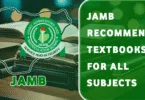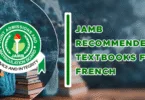JAMB Recommended Textbooks For Fine Arts 2026/2027: Fine Arts goes beyond talent or drawing. It requires creativity, design, culture, and the history of art itself. The right textbooks will help you understand all these and prepare you for JAMB questions accurately.
If you are preparing for the JAMB Fine Arts 2026/2027 UTME, one of the most important steps toward scoring high is reading with the right textbooks. In this article, you’ll find the full list of JAMB-recommended Fine Arts textbooks, a guide on how to use them effectively, what to expect in the exam, and answers to common questions asked by candidates.
READ ALSO: JAMB Syllabus for Fine Art 2026/2027 | Download PDF
What To Expect In JAMB Fine Arts
Fine Arts examination in JAMB is not about drawing or painting. It’s about understanding art. The questions are usually straightforward, but they require that you have studied and are prepared to answer them.
The questions are 100% Computer-Based, multiple-choice and it is designed to test your knowledge majorly on these areas:
- Elements and principles of design
- Techniques of drawing, painting, and sculpture
- Art history (especially African and European art)
- The meaning and purpose of art
- Art appreciation and criticism
Full List of JAMB Recommended Textbooks for Fine Arts 2026/2027
Below is the official list of Fine Arts textbooks approved by the Joint Admissions and Matriculation Board (JAMB) for the 2026/2027 UTME session.
- Appreciating Art in Africa by E.H. Gombrich (Heinemann Educational Books)
- Art and Craft for Secondary Schools by G. N. Anyabolu (Africana Educational Publishers)
- Creative Arts for Schools and Colleges by C. N. Nwosu (Fourth Dimension Publishing Co. Ltd)
- Understanding Art Movements by R. J. Belton (Longman Publishers)
- The Story of Art by E. H. Gombrich (Phaidon Press)
- Fundamentals of Drawing and Painting by A. M. Odunlade (Spectrum Books Ltd).
- African Art: An Introduction by Frank Willett (Thames and Hudson)
- The Essential Fine Arts Guide by J. O. Uche (University Press Ltd)
- A Handbook of Nigerian Art and Artists by E. O. Ekwueme (Macmillan Nigeria Publishers)
- History of Art: Ancient to Modern Times by H. Gardner (Harcourt Brace Jovanovich)
Note: These books are drawn directly from the Fine Arts syllabus and contain all you need to understand both theory and art appreciation.
Why Textbooks Are Necessary Preparing For Fine Arts In JAMB
Fine Arts is deeply interpretive. That means memorization alone won’t be enough you’ll need to understand context, symbolism, and artistic techniques.
The textbooks listed above provide that depth. Some explain how artworks are created (drawing, painting, sculpture, and ceramics), others discuss why art was made by delving into culture, religion, and social commentary, while a few deal on art criticism and appreciation, teaching you how to analyze and describe art effectively which is a skill JAMB often tests its candidates indirectly.
So when doing your reading, don’t just “cram”. Instead, observe patterns, and seek understanding of how ideas connect and visualize artworks as stories worth telling.
How To Use The JAMB Fine Arts Textbooks Smartly
Having the right books is one thing; using them wisely is another.
- Start with the basics: Begin with topics like Elements of Art and Principles of Design before going into history or criticism. You will find that once you understand the basics, everything else becomes clearer.
- Take notes in your own words: Don’t just copy down definitions. Write short explanations you can easily remember when revising.
- Note artists and art periods: Make a list of famous names and their contributions because JAMB often frames questions around those areas.
- Use one main textbook: The many textbooks listed are not meant to be used concurrently. You can use only one main textbook and another as reference to gain deeper insights. For example, Art and Craft for Secondary Schools as your main textbook, and The Story of Art as your secondary reference.
- Compare local and foreign art: This will help your ability to answer questions linking African and Western artistic traditions.
Conclusion
Fine Arts is one of the most expressive and intellectually rewarding subjects in JAMB. It is not a subject you can rush through or memorize overnight. To do well, study with the recommended textbooks, focus how art connects to culture, and understand the meaning behind what you read.
Interestingly, most JAMB Fine Arts questions are context-based; meaning, you might be presented with an art concept and asked what it represents, rather than asking for mere definitions. Treat fine arts as a journey through creativity instead of seeing it as just any exam.
FAQs
Do I need all the recommended textbooks?
Answer: No. Two or three are enough. Choose one general textbook and another for art history or African art. What matters most is how consistently you study and not the multitude of textbooks you consult.
Will JAMB ask me to draw?
Answer: No. JAMB Fine Arts focuses on theory and appreciation, not actual drawing. You will be tested on art terms, styles, history, evaluation and not sketching.
Is it easy to score high in Fine Arts in JAMB?
Answer: Yes. Students who prepare properly score very high in Fine Arts because the questions are usually straightforward and strictly syllabus-based.
Which topics in fine arts have the most repeated questions in JAMB?
Answer: Over the years, majority of the questions usually come from Art history (African and European), Elements and principles of design, Nigerian traditional art, and Art appreciation.
Can I pass Fine Arts in JAMB even if I am not good at drawing?
Answer: Yes. Drawing skill is not required to pass JAMB Fine Arts.





